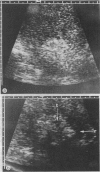Abstract
The use of local hyperthermia to treat cancer of the internal organs has been limited by the difficulty of controlling delivery of heat and limiting the effects to the tumour, but this can be overcome by using laser light transmitted through thin flexible fibres. Laser energy was delivered to tumours through fibres inserted percutaneously through needles directly into the centre of the tumour area. Ultrasound scanning was used to locate the tumour, position the fibres correctly within the tumour, and monitor the development of thermal necrosis in real time during laser exposure and through the subsequent period of healing. Five patients were treated (one with a tumour of the breast, one with a subcutaneous secondary tumour, one with a recurrent pancreatic tumour, and two with secondary tumours in the liver). Tumour necrosis was found on ultrasonography or computed tomography in all, and there were no immediate or delayed complications. In one patient the size of the isolated secondary tumour in the liver had not increased over 10 months, and he subsequently showed no other evidence of residual cancer. To develop this technique careful studies are essential to ensure that in every case the extent of thermal necrosis produced by absorption of the laser light can be matched to the full extent of the tumour being treated and that there is always sufficient adjacent normal tissue to ensure safe healing. These preliminary results suggest that this simple technique can be applied safely and effectively to common tumours in humans; more extensive trials in a range of cancers of solid organs are warranted.
Full text
PDF



Images in this article
Selected References
These references are in PubMed. This may not be the complete list of references from this article.
- Bown S. G. Phototherapy in tumors. World J Surg. 1983 Nov;7(6):700–709. doi: 10.1007/BF01655209. [DOI] [PubMed] [Google Scholar]
- Dritschilo A., Grant E. G., Harter K. W., Holt R. W., Rustgi S. N., Rodgers J. E. Interstitial radiation therapy for hepatic metastases: sonographic guidance for applicator placement. AJR Am J Roentgenol. 1986 Aug;147(2):275–278. doi: 10.2214/ajr.147.2.275. [DOI] [PubMed] [Google Scholar]
- Lindholm C. E., Kjellen E., Nilsson P., Hertzman S. Microwave-induced hyperthermia and radiotherapy in human superficial tumours: clinical results with a comparative study of combined treatment versus radiotherapy alone. Int J Hyperthermia. 1987 Sep-Oct;3(5):393–411. doi: 10.3109/02656738709140410. [DOI] [PubMed] [Google Scholar]
- Matthewson K., Coleridge-Smith P., O'Sullivan J. P., Northfield T. C., Bown S. G. Biological effects of intrahepatic neodymium:yttrium-aluminum-garnet laser photocoagulation in rats. Gastroenterology. 1987 Sep;93(3):550–557. doi: 10.1016/0016-5085(87)90918-8. [DOI] [PubMed] [Google Scholar]
- Shiina S., Yasuda H., Muto H., Tagawa K., Unuma T., Ibukuro K., Inoue Y., Takanashi R. Percutaneous ethanol injection in the treatment of liver neoplasms. AJR Am J Roentgenol. 1987 Nov;149(5):949–952. doi: 10.2214/ajr.149.5.949. [DOI] [PubMed] [Google Scholar]
- Shipley W. U., Nardi G. L., Cohen A. M., Ling C. C. Iodine-125 implant and external beam irradiation in patients with localized pancreatic carcinoma: a comparative study to surgical resection. Cancer. 1980 Feb 15;45(4):709–714. doi: 10.1002/1097-0142(19800215)45:4<709::aid-cncr2820450416>3.0.co;2-5. [DOI] [PubMed] [Google Scholar]
- Storm F. K., Kaiser L. R., Goodnight J. E., Harrison W. H., Elliott R. S., Gomes A. S., Morton D. L. Thermochemotherapy for melanoma metastases in liver. Cancer. 1982 Mar 15;49(6):1243–1248. doi: 10.1002/1097-0142(19820315)49:6<1243::aid-cncr2820490628>3.0.co;2-y. [DOI] [PubMed] [Google Scholar]





